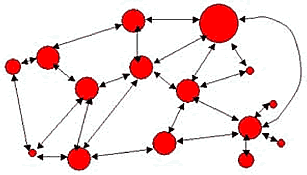Submitted by Sheldon Rampton on
 In their groundbreaking 1988 book, Manufacturing Consent, professors Ed Herman and Noam Chomsky not only explained, but documented with extensive case studies, how mass media and public opinion are shaped in a democracy. Twenty years later, can their "propaganda model" still be used to explain modern media distortions? That was one of the main questions discussed last week at a conference in Windsor, Ontario, titled "20 Years of Propaganda?" Organized by Dr. Paul Boin, the conference drew hundreds of scholars and activists including myself, and more than 1,000 people attended a closing speech by Chomsky on May 17.
In their groundbreaking 1988 book, Manufacturing Consent, professors Ed Herman and Noam Chomsky not only explained, but documented with extensive case studies, how mass media and public opinion are shaped in a democracy. Twenty years later, can their "propaganda model" still be used to explain modern media distortions? That was one of the main questions discussed last week at a conference in Windsor, Ontario, titled "20 Years of Propaganda?" Organized by Dr. Paul Boin, the conference drew hundreds of scholars and activists including myself, and more than 1,000 people attended a closing speech by Chomsky on May 17.
The "propaganda model" that Herman and Chomsky put forward in Manufacturing Consent has made the book notable (some would say notorious) as the most influential book by serious academics to challenge the common dogma of media objectivity in the United States. When it first appeared, it was almost unheard-of to suggest that U.S. media such as the New York Times, Time and Newsweek magazines and CBS News were propaganda vehicles.
Today things are somewhat different. Across the political spectrum, there is a widespread belief that disinformation, deception and propaganda pervade the media. On the internet, the initials MSM have become a standard term of disparagement for untrustworthy "mainstream media." The right has in fact far surpassed the left at denouncing the myth of media objectivity and has developed an entire industry of think tanks, media watchdogs and pundits such as Michelle Malkin or Anne Coulter who devote themselves to discovering and denouncing purported instances of media bias -- while enjoying privileged media access themselves.
Based on my own experiences -- as a Central American solidarity and antiwar activist during the 1980s, as the co-author of two books about Iraq titled Weapons of Mass Deception and The Best War Ever, and as someone who studies the public relations industry and propaganda in general at the Center for Media and Democracy (CMD) -- I see no shortage of evidence showing that propaganda is very much alive and well as a force shaping public opinion and public policy.
Propaganda Model Holds True for Iraq
When considering media coverage of the current war in Iraq, much of Herman and Chomsky's propaganda model is directly relevant. For example, they identify the differential treatment given to "worthy" vs. "unworthy" victims of violence as a signature characteristic of propaganda. "A propaganda system," they wrote, "will consistently portray people abused in enemy states as worthy victims, whereas those treated with equal or greater severity by its own government or clients will be unworthy. The evidence of worth may be read from the extent and character of attention and indignation."
 In The Best War Ever, John Stauber and I examined this aspect of media coverage of the war in Iraq in a chapter titled "Not Counting the Dead." One of the things that distinguishes the current war from past wars -- including World War II or even the Vietnam War -- is that even the United States soldiers who have died or suffered injuries are included among the "unworthy victims" whose suffering is to be treated in a sanitized, minimal way. As an example, we examined ABC-TV Nightline's broadcast of "The Fallen," an April 2004 program that consisted in its entirety of a narrator reading the names of the soldiers who had died by that date in Iraq, accompanied by still photographs of their faces. This broadcast, more than a year after the war began, was considered controversial at the time for its unusual frankness in mentioning the dead at all. One media company, the Sinclair Broadcast Group, ordered its ABC affiliates not to carry the broadcast on grounds that "appears to be motivated by a political agenda designed to undermine the efforts of the United States in Iraq." In reality, the broadcast was an exercise in minimalism if we compare it to the photos that were published documenting the horrors of past wars. During the U.S. Civil War, for example, Mathew Brady's photographs of bodies sprawled across the battlefield at Antietam were incomparably more graphic, shocking and evocative than the limited, ceremonial and sanitized report that appeared on Nightline.
In The Best War Ever, John Stauber and I examined this aspect of media coverage of the war in Iraq in a chapter titled "Not Counting the Dead." One of the things that distinguishes the current war from past wars -- including World War II or even the Vietnam War -- is that even the United States soldiers who have died or suffered injuries are included among the "unworthy victims" whose suffering is to be treated in a sanitized, minimal way. As an example, we examined ABC-TV Nightline's broadcast of "The Fallen," an April 2004 program that consisted in its entirety of a narrator reading the names of the soldiers who had died by that date in Iraq, accompanied by still photographs of their faces. This broadcast, more than a year after the war began, was considered controversial at the time for its unusual frankness in mentioning the dead at all. One media company, the Sinclair Broadcast Group, ordered its ABC affiliates not to carry the broadcast on grounds that "appears to be motivated by a political agenda designed to undermine the efforts of the United States in Iraq." In reality, the broadcast was an exercise in minimalism if we compare it to the photos that were published documenting the horrors of past wars. During the U.S. Civil War, for example, Mathew Brady's photographs of bodies sprawled across the battlefield at Antietam were incomparably more graphic, shocking and evocative than the limited, ceremonial and sanitized report that appeared on Nightline.
When it comes to Iraqi victims of the war, the coverage has been even more limited. Whereas there is at least an available count of the American war dead, U.S. journalists have not challenged military spokespeople's claim that counting Iraqi civilian deaths would be "irresponsible" because of the difficulties in giving "firm estimates given the wide range of variables" which make it "impossible for us to maintain an accurate account." Researchers from Johns Hopkins University and Al Mustansiriya University in Baghdad have conducted two separate surveys of Iraqi mortality. By 2006 they concluded that the war had claimed an estimated 650,000 lives, but their research was largely ignored in the America media, aside from brief mentions in the New York Times, Washington Post and Wall Street Journal, which declared that their findings were "controversial," "cooked up," "bogus" or "politically motivated" -- even though the researchers had used state-of-the-art survey techniques widely recognized as the best methodology for estimating deaths in other war zones previously.
For examples of other propaganda patterns predicted in Manufacturing Consent, such as media reliance on information supplied by official sources, we have Judith Miller's credulous reports in the New York Times about aluminum tubes and other alleged proof of Iraqi weapons of mass destruction. We have numerous studies conducted by FAIR of guests on evening newscasts, in which they found that 75 percent of the sources quoted were either current or former government or military officials, only one of whom expressed opposition to the war. Official sources are also the main ones cited in more recent "news analysis" in the New York Times, such as Michael Gordon's piece titled "Get Out of Iraq Now? Not So Fast, Experts Say," or David Sanger's "The Only Consensus on Iraq: Nobody's Leaving Right Now."
In short, the war in Iraq offers plenty of evidence showing that the information presented in U.S. media distorts reality and that those distortions have been the basis for the degree of public support of the war which still exists -- even though public support has fallen. These aspects of the critique by Herman and Chomsky therefore remain relevant and important today.
The Five Filters
At the same time, the history of the past 20 years since the book was written suggests that the five "filters" highlighted in the first chapter of Manufacturing Consent -- media ownership, the importance of advertising, reliance on official sources, "flak" produced by wealthy interest groups, and anti-communism as an ideological control mechanism -- serve better as descriptions of the media as they existed then in the United States than they do of media as they exist today.
The five filters are an essential part of the Herman-Chomsky propaganda model, because they provide a way of explaining how propaganda can enter the media in a Western democratic society, without an overt system of outright coercion or censorship. It is easy, of course, to understand how propaganda enters the media in authoritarian systems like the former Soviet Union or Saddam Hussein's Iraq: anyone who fails to recite official dogma simply gets imprisoned or killed.
The propaganda filters described in Manufacturing Consent explain how the "free market" system itself can screen out "unacceptable" ideas, without the use of guns and gulags. This analysis provides a structural explanation for propaganda, unlike most right-wing critiques of the media, which rely simply on psychological assumptions about journalists (they "hate America" or have a "liberal bias") to explain why the media fail to more fully reflect their own values.
 I would argue, however, that the five filters described by Herman and Chomsky are specific to the mass media in the United States during the period when they wrote their book. Today, the media are changing.
I would argue, however, that the five filters described by Herman and Chomsky are specific to the mass media in the United States during the period when they wrote their book. Today, the media are changing.
The rise of propaganda during the 20th century in part reflected the cultural and political effects of two world wars as well as the Cold War. It was reflected the culmination of the industrial revolution and the dominance of certain specific communications technologies -- newspapers, radio, television -- capable of mass-producing and broadcasting messages for public consumption. As the word "manufacturing" in Manufacturing Consent suggests, the mass media throughout the 20th century were largely based on a model of mass production similar to the assembly lines and railroads of the industrial revolution: a command-and-control system overseeing the production of messages that emanate outward from major hubs. This model was envisioned metaphorically in the now-iconic logo of RKO Pictures, which depicted a huge radio tower atop the earth, from which messages radiated electronically to the planet.
These were the technologies and political forces that defined the media when Manufacturing Consent was written. In 1988, cable and satellite television had only recently emerged as important media and were only briefly mentioned in the text of the book, while the internet was not mentioned at all.
 Today, in place of "broadcasting" we hear increasingly of "narrowcasting." Rather than a single mass audience consuming the same broadcast information, we have multiple audiences, interests, and information channels. The emergence of new communications media challenge the propaganda/broadcast model by increasing the number of channels through which information reaches the public, and also by lowering the costs of entry to previously-excluded voices. On the internet in particular, blogging, virally-distributed email and collaboratively-written wikis have changed the traditional distinction between "broadcaster" and "audience." Instead of relying on "one-to-many" broadcasts, people can now get information through "one-to-one" and "many-to-many" systems in which they themselves choose and create their own media from diverse sources.
Today, in place of "broadcasting" we hear increasingly of "narrowcasting." Rather than a single mass audience consuming the same broadcast information, we have multiple audiences, interests, and information channels. The emergence of new communications media challenge the propaganda/broadcast model by increasing the number of channels through which information reaches the public, and also by lowering the costs of entry to previously-excluded voices. On the internet in particular, blogging, virally-distributed email and collaboratively-written wikis have changed the traditional distinction between "broadcaster" and "audience." Instead of relying on "one-to-many" broadcasts, people can now get information through "one-to-one" and "many-to-many" systems in which they themselves choose and create their own media from diverse sources.
Let's look at how the internet functions with relation to the five filters described by Herman and Chomsky.
1. Media Ownership
In Manufacturing Consent, Herman and Chomsky state that "the cost of machinery alone, of even very small newspapers, has for many decades run into the hundreds of thousands of dollars" and call this "the first filter -- the limitation on ownership of media with any substantial outreach by the requisite large size of investment."
On the internet, however, someone can set up their own website with its own domain name for a hosting fee as low as a few dollars per month. At no additional charge, they can download and install free open source software to add interactive features comparable in sophistication to those available on internet versions of major newspapers.
A number of highly successful websites have begun in just this fashion. Craigslist, which now has local versions in every major city in the United States and many mid-sized cities, began as a personal online mailing list maintained by Craig Newmark. Wikipedia, which is currently one of the ten most highly-visited websites in existence, only had a single employee during the first two years of operation (and laid him off for lack of funds shortly before its traffic began to hit the stratosphere).
For large, heavily-trafficked websites, obviously there are expenses involved in maintaining servers, software upgrades, content creation and so forth. However, the price of entry into internet publishing is dramatically lower than the price of entry into traditional media such as newspapers and television.
2. Advertising
Herman and Chomsky consider advertising "the second filter," arguing that "The advertisers' choices influence media prosperity and survival. The ad-based media receive an advertising subsidy that gives them a price-marketing-quality edge, which allows them to encroach on and further weaken their ad-free (or disadvantaged) rivals."
On the internet, by contrast, advertising-heavy websites may attract more revenue than ad-free sites, but the ads themselves are perceived as such a nuisance by readers that they hardly provide a quality advantage. Moreover, the advertising model used by many sites, including bloggers in particular, relies heavily on Google ads, in which the selection of advertisements for inclusion on a page is based on search engine-driven keyword matches in which advertisers seek to place their ads on sites relevant to their products. In practice virtually any website will contain content that matches some advertiser's keywords, so this system does not impose much pressure on sites to tailor their content to advertisers' wishes (although it probably does create an incentive for the creation of online porn).
Moreover, many of the top websites in existence have challenged the influence of advertising in other ways. Wikipedia's users have generally opposed placing even Google ads on their site, even though doing so would generate tens of millions of dollars annually. Instead, they have raised funds through appeals for donations from users and, only recently, though corporate and foundation grants. The Craigslist website actually runs free advertisements and has been a source of consternation for traditional newspapers, which are seeing their own revenues from classified ads as marketing money shifts to online venues.
3. Reliance on Official Sources
The internet has given rise to a phenomenon called "citizen journalism" which assumes, from the outset, that any amateur can be a journalist -- a trend that has drawn both complaints and interest from conventional journalists.
In South Korea, OhmyNews became popular and commercially successful with the motto, "Every citizen is a reporter." It has a staff of some 40-plus traditional reporters and editors who write about 20 percent of its content, with the rest coming from other freelance contributors who are mostly ordinary citizens. Similar examples of this trend include websites like Wikinews, ePluribusMedia, NewAssignment.net and CMD's own wiki, SourceWatch.
Much of traditional journalists' reliance on official sources is based on their regular "beats." It happens at all levels of journalism. I used to work as a newspaper reporter for a small daily paper (circulation: 7,000) in the town of Portage, Wisconsin. Simply by virtue of the fact that I covered city council and county board meetings, I quickly became acquainted with the mayor, the local sheriff, local businesspeople, etc. When those are the people you bump into regularly, they become your sources. That dynamic is somewhat different, however, with citizen journalists. Just as anyone can become a journalist, anyone can become a source.
The first photograph of flag-draped coffins returning from Iraq was not taken by a traditional journalist but by Tami Silicio, a cargo worker in Kuwait who worked loading the coffins into airplanes for shipment home. She took the picture with a digital camera, emailed it to a friend back home, who took it to the Seattle Times. (After it was published, Tami was fired from her job.) The damning photos of human rights abuses at Abu Ghraib were also not taken by journalists but by the abusers themselves, who documented their own crimes. And it was another soldier, Sergeant Joseph Darby, who discovered the photos, copied them onto a CD, and exposed the scandal. In both of these instances, the ease with which digital media can be reproduced and transmitted helped bypass the filter of official sources.
4. Flak
Herman and Chomsky define "flak" as "negative responses to a media statement or program. it may take the form of letters, telegraphs, phone calls, petitions, lawsuits, speeches and bills before Congress, and other modes of complaint, threat, and punitive action."
(Note that "flak" is different from "flack," a derogatory term for publicists.)
Many of the new internet media are sources of flak, and people across the spectrum of American politics have learned to use flak for their own purposes. On the internet itself, however, flak is not much of a deterrent to free discourse. Lawsuits are difficult to mount and even more difficult to win, especially given the ease with which people can blog or email anonymously. If anything, the "negative responses" that Herman and Chomsky describe help fuel the popularity of popular websites like the Daily Kos or Drudge Report, which attract much of their audience precisely by stirring passionate and even ugly debate.
5. Anti-Communism
With the end of the cold war, anti-communism has faded somewhat as a national ideology. These days much of this sort of rhetoric is couched in the language of "anti-terrorism" or "anti-Islam" -- or, more generally, anti-anti-Americanism. The use of anti-communism as a filtering ideology should probably be seen, therefore, as simply one example of a broader filter, namely, "nationalism as an ideological control mechanism."
Rhetoric vs. Reality
Enthusiasts of new media are fond of declaring that the internet "changes everything." Today, we are told, "markets are conversations." Corporations and other elites must therefore listen to their stakeholders as never before. Secrecy and manipulation from above can supposedly no longer survive the harsh glare of public scrutiny in this new media environment.
The importance of these developments should not be underestimated, but they should not be exaggerated either. The trends I described above may seem to contradict some of the analysis presented in Manufacturing Consent, but thus far things haven't changed all that much. Far from it. Any serious contemplation of the process by which the United States went to war in Iraq tells us that propaganda is still a powerful force in shaping public opinion. As the growing public unrest with the war demonstrates, propaganda is not all-powerful, but it has been powerful enough to create war hysteria against a country that posed no threat to the American people and to keep Americans mired in that war for four years and counting.
One reason that things have not changed as much as the techno-utopians imagine is that the traditional broadcast media remain the dominant media today. Television is still the main medium through which Americans get their information about the world. Much of the ferment that I have been describing on the blogosphere actually consists of people discussing what they have seen on TV, read in newspapers or heard on the radio. New media such as the internet will undoubtedly continue to grow in importance as time progresses, but their actual impact to date is still limited.
Another, equally important factor, is that although the specific filtering mechanisms that Herman and Chomsky describe in Manufacturing Consent may not apply in the same ways to the internet, new techniques of molding and directing public opinion are emerging along with the new media.
The Edelman public relations firm, for example, has created what they call a "me2revolution" unit that focuses specifically on developing PR techniques for new internet media. Edelman recently partnered with Technorati, a leading search engine devoted specifically to bloggers. Edelman is funding an "accelerated development effort" to expand Technorati's search capabilities into languages including Chinese, Korean, German, Italian and French. In exchange, they hope to gain the ability to better monitor what bloggers are saying about their clients. And they're not just listening. Edelman is also resposible for the coinage of a new term: "flog" for "fake blog." On behalf of Wal-Mart Stores, their employees have posed as "grassroots" bloggers on two Wal-Mart-sponsored websites, "Working Families for Wal-Mart" and "PaidCritics.com," which -- rather ironically -- slams the "paid critics [who are] smearing Wal-Mart." Here we see a long-standing propaganda tactic -- the creation of front groups -- being retooled for the internet.
With regard to Iraq, we've also seen the military experimenting with various internet-based PR strategies including posting its own videos on Google Video and YouTube and hired the PR firm of Manning, Selvage & Lee to help distribute pro-war content feeds to "milbloggers." More recently, they have tried blocking internet access for active-duty soldiers. While these may appear to be contradictory strategies, both seek to control the messages relayed online.
As new technology enters the mainstream, therefore, we can expect changes in the techniques used to influence public opinion, but institutions with wealth and power will continue to do so. Power still concedes nothing without a struggle.
This article is adapted from Sheldon Rampton's presentation at the University of Windsor's conference on "20 Years of Propaganda?"
Many of the links in the above article are to articles on SourceWatch, the Center for Media and Democracy's collaborative online encyclopedia. SourceWatch volunteer editors can help update, expand and improve these or any of the other SourceWatch profiles of people, issues and groups shaping the public agenda. It's free to sign up, and we'd love to have you join us.

Comments
Dissident93 replied on Permalink
Error on Lancet study
Sheldon Rampton replied on Permalink
Not quite
Dissident93 replied on Permalink
Garfield criticised 2006 study in letter to Lancet